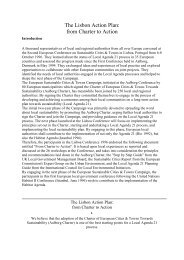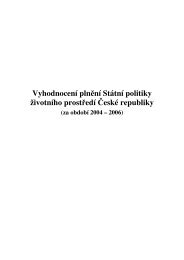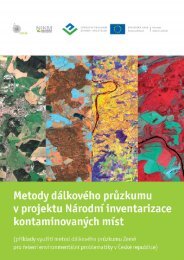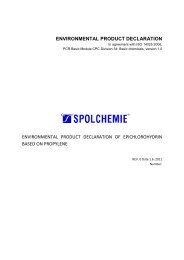Environmental Technologies and Eco-innovation in the Czech ...
Environmental Technologies and Eco-innovation in the Czech ...
Environmental Technologies and Eco-innovation in the Czech ...
You also want an ePaper? Increase the reach of your titles
YUMPU automatically turns print PDFs into web optimized ePapers that Google loves.
Technology Platform for Biofuels <strong>in</strong> Transport <strong>and</strong> <strong>the</strong> Chemical Industry was established.<br />
Its ma<strong>in</strong> aim is <strong>the</strong> susta<strong>in</strong>able production of biofuels <strong>in</strong> <strong>the</strong> <strong>Czech</strong> Republic.<br />
In order to thoroughly survey <strong>the</strong> market with chemical agents <strong>and</strong> substances<br />
<strong>and</strong> to prevent unauthorized chemicals from enter<strong>in</strong>g <strong>the</strong> market, <strong>the</strong> EU adopted<br />
a new chemical policy (REACH 3 ) <strong>in</strong> 2006. This was <strong>in</strong>corporated <strong>in</strong>to <strong>Czech</strong> legislation<br />
by Act No. 356/2003 Coll., on chemical substances <strong>and</strong> chemical preparations. The<br />
implementation of REACH will ensure that only those chemicals that have known<br />
properties <strong>and</strong> do not represent a threat to production plant personnel, product<br />
users <strong>and</strong> <strong>the</strong> environment will be produced <strong>and</strong> used <strong>in</strong> <strong>the</strong> EU by 2020. The act on<br />
chemical agents <strong>and</strong> preparations also m<strong>and</strong>ates <strong>the</strong> mark<strong>in</strong>g of chemical products.<br />
7.1 | Anil<strong>in</strong>e production us<strong>in</strong>g waste heat<br />
Anil<strong>in</strong>e is an organic compound used <strong>in</strong> <strong>the</strong> production of azo-dyes 4 <strong>and</strong> drugs.<br />
Anil<strong>in</strong>e production is subject to a research conducted at <strong>the</strong> Institute of Chemical<br />
Technology <strong>in</strong> Prague <strong>in</strong> cooperation with BorsodChem MCHZ, s.r.o. The pr<strong>in</strong>ciple of<br />
anil<strong>in</strong>e production is <strong>the</strong> catalytic reduction 5 of nitrobenzene 6 by us<strong>in</strong>g hydrogen<br />
through many columns for <strong>in</strong>sulat<strong>in</strong>g pure anil<strong>in</strong>e. There are several reduction systems<br />
that basically differ <strong>in</strong> <strong>the</strong> reactor <strong>and</strong> catalyst used. Adjustments to technology <strong>and</strong><br />
subsequent <strong>in</strong>creases <strong>in</strong> anil<strong>in</strong>e production capacity to 150 kilotons per year toge<strong>the</strong>r<br />
with many modifications aimed at reduc<strong>in</strong>g <strong>in</strong>vestment costs <strong>and</strong> improv<strong>in</strong>g power<br />
consumption made <strong>the</strong> process self-sufficient <strong>in</strong> terms of heat consumption; <strong>in</strong><br />
addition, it produces up to 1 ton of steam per 1 ton of anil<strong>in</strong>e. This is used externally<br />
<strong>in</strong> nitrobenzene production. Thanks to better use of <strong>the</strong> power produced dur<strong>in</strong>g <strong>the</strong><br />
production process, no external power resources are required. In 2003, <strong>the</strong> knowhow<br />
<strong>and</strong> a licence for produc<strong>in</strong>g 150 kilotons of anil<strong>in</strong>e per year were sold to Tosoh<br />
Corporation, a Japanese company. After <strong>the</strong> Japan unit was put <strong>in</strong>to operation <strong>in</strong> 2005,<br />
<strong>the</strong> technology has been produc<strong>in</strong>g almost 10% of <strong>the</strong> world’s consumption of anil<strong>in</strong>e.<br />
The <strong>Czech</strong> Republic produces 5%, which is <strong>the</strong> largest amount with<strong>in</strong> basic chemical<br />
products.<br />
3 REACH – Regulation (EC) No 1907/2006 on <strong>the</strong> registration, evaluation, authorisation <strong>and</strong> restriction of chemicals <strong>and</strong> on <strong>the</strong><br />
establishment of a European Chemicals Agency, REACH (Registration, Evaluation <strong>and</strong> Authorization of CHemicals)<br />
4 azo-dyes – <strong>the</strong> most numerous <strong>and</strong> <strong>the</strong> most important group of organic dyes that <strong>in</strong>cludes all shades from yellow to black<br />
5 catalytic reduction – chemical reactions with <strong>the</strong> use of a catalyst<br />
6 nitrobenzene – an organic compound, <strong>the</strong> basic raw material for <strong>the</strong> production of anil<strong>in</strong>e <strong>and</strong> azo-dyes<br />
90 | 91
















